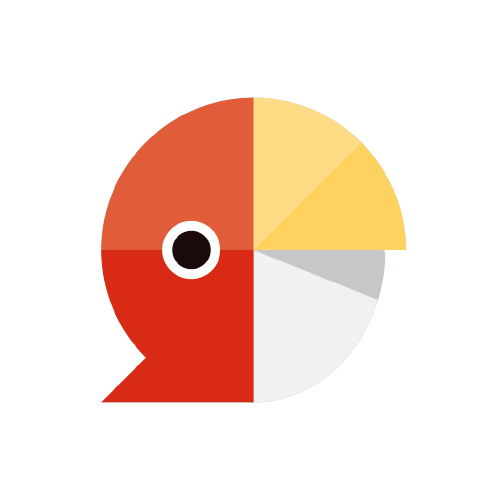Writing a Spanish Resume: Your Guide to Impressing Employers
It takes more than just translating your CV into Spanish to get employment in a Spanish-speaking country! You also need to be aware of and adjust to the expectations and work culture of the area 🙂
In case you don’t know where to start or need some sort of inspiration, this detailed guide will take you through the process of writing a Spanish resume that appeals to Spanish employers and successfully conveys your abilities.
Grab pen and paper, be ready to start writing your CV in Spanish right away and compare it with one of the most requested Spanish resume samples!
Understanding the Basics of a Spanish Resume
A work resume, often referred to as a "currículum" in Spanish-speaking nations, is a document that gives prospective employers a first impression by demonstrating your qualifications for the position you're looking for.
Even if this may sound familiar, you should know that a Spanish resume frequently contains components that are not utilised in English-speaking nations.
For instance, it's commonplace in Spain and Latin America to include private details like your date of birth and even a picture of yourself that would often be left out elsewhere.
It is important to create a work resume in Spanish that is both personalised and well-structured because it:
- Emphasises Your Experiences and Skills: It makes it simpler for employers to determine whether you are a good fit for the position by enabling you to clearly and succinctly convey your qualifications.
- Shows Language Proficiency: It demonstrates your capacity for successful Spanish communication, which is frequently a crucial prerequisite for employment in Spanish-speaking areas.
- Respects Local Norms: It makes sure your application is prepared and presented in accordance with the norms and requirements of the Spanish employment market, improving your chances of getting the job.
Key Sections and Skills in Spanish for a Resume
To write a CV in Spanish, you should get familiar with a certain terminology.
- Datos Personales (Personal Information): This should contain your complete name, a professional photo, your contact information, and maybe your nationality, among other important things.
- Perfil Profesional (Professional Profile): Format this part like a pitch, highlighting your qualifications and professional experience. It needs to be interesting and relevant to the particular position you're looking for. Those who are shifting sectors or have less professional experience may find this section extremely useful.
- Experiencia Laboral (Work Experience): Describe your prior roles, duties, and major successes by providing a reverse chronological list. When you can, quantify your results to give specific examples of your talents.
- Formación Académica (Education): Include relevant courses, workshops, and seminars that are in line with the career you're aiming for in addition to mentioning degrees. Use a reverse chronological list.
- Habilidades (Skills): Hard and soft skills should be included here. Emphasise your industry-specific software or technologies, language ability, and soft skills like communication and leadership.
- Idiomas (Languages): Especially crucial in international businesses or areas with various language requirements. Using adjectives like "native," "fluent," "professional working proficiency," etc., rate your competence honestly. You can also consult the Spanish CEFR, which grades Spanish from A2 to C2, to get a clearer picture of your proficiency. Internationally recognised as the benchmark framework, the CEFR is applicable in both European and Latin American nations. You can find more information on the Cervantes website.
- Información Adicional (Additional Information): Include any extracurricular activities, volunteer experience, or other interests that can help your application stand out. Verify that the information in this area relates to the job you're applying for. You can also include:
- Logros (Achievements): Emphasise remarkable successes that have quantifiable outcomes.
- Certificaciones (Certifications): Make a note of any pertinent certifications that raise your stature in the industry.
How to Make a Resume in Spanish: Step-by-Step Guide
Ready to write your resume in Spanish? As you read, follow these steps, and be prepared to compare yours with the example of a common resume in Spanish I'll provide at the end.
Step 1: Choose the Right Resume Format
Choose the format that best fits your background in the workplace before you start:
- Chronological Resume: It is best suited for candidates with a strong background in the field for which they are applying.
- Functional Resume: Emphasises experience and abilities above a list of previous jobs. If you have gaps in your job history or are changing careers, this is appropriate.
- Combination Resumes: Effective for those with relevant talents and professional experiences since they include functional and chronological aspects and highlight both job history and skills.
- Europass CV: A standardised document used in Europe to present everything in a clear, uniform manner to make these qualifications visible and comprehensible across European borders. However, some companies may prefer a more personalised CV structure. Double-check job requirements and contact HR via LinkedIn if Europass is not required or choose a format that suits you better.
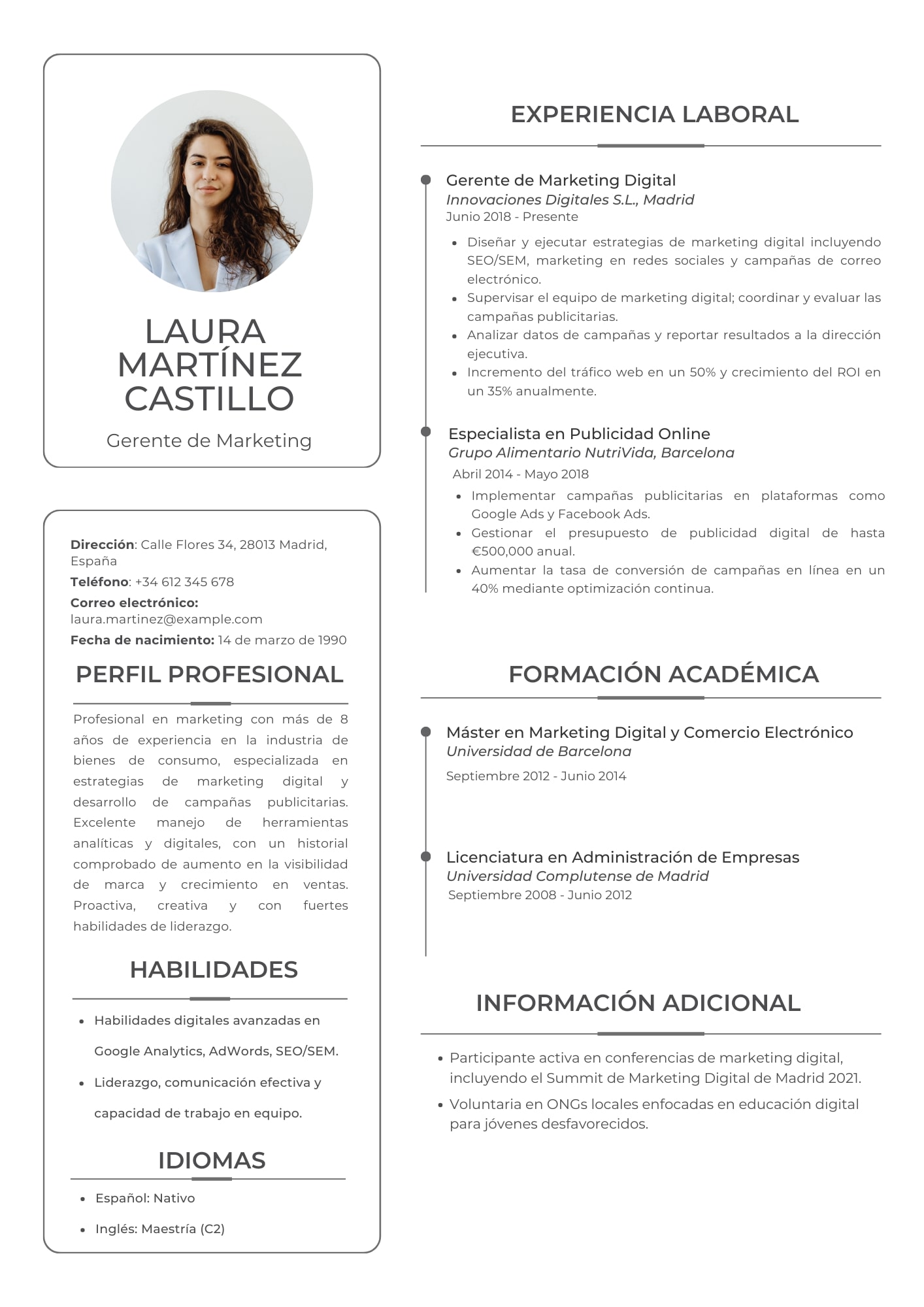
Step 2: Gather Personal Information
- Full Name: Write your full name at the top of the resume.
- Contact Information: Teléfono + correo electrónico
- Address / Dirección: List your current address.
- Date of Birth / Fecha de nacimiento: dd/mm/yyyy
- Professional Photo: Attach a recent, professional-looking photo to the top corner of the resume.
- Nationality: Optional, depending on the job and country.
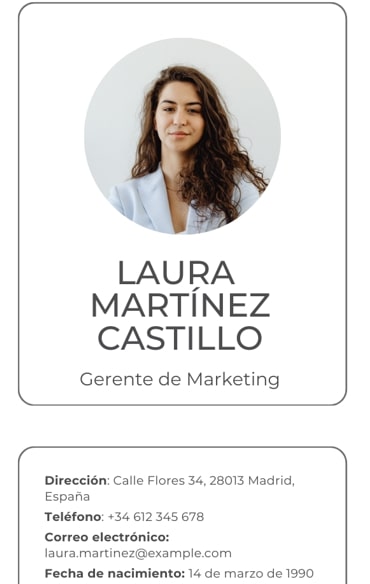
Step 3: Write a Professional Profile (Perfil Profesional)
- Briefly describe your professional goals and what you hope to provide to prospective companies. Include a 2-3 sentence overview of your professional background that highlights your primary talents and experiences relevant to the position you're looking for.
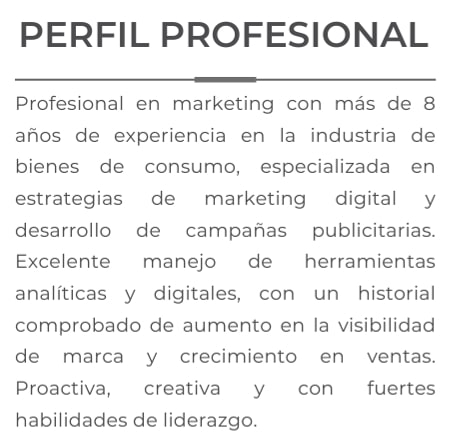
Step 4: Detail Your Work Experience (Experiencia Laboral)
You should include all your related work experience in a reverse chronological order, so start with your most recent job and work backwards. Make sure you include the following information for each work experience:
- Company and Location: State the name and location of each company you worked for.
- Dates of Employment: Include the month and year you started and ended each position.
- Job Title: List your position.
- Key Responsibilities and Achievements: Use bullet points to highlight your major responsibilities and any significant accomplishments for each job. Use action verbs to start each point, and mention quantitative results whenever possible. Use terms from the job description and, when feasible, use figures to quantify achievements.
Do you have little to no job experience, or are you shifting industries? Remember that all experience counts, even voluntary work or projects. Just be sure to mention it, and focus on what you accomplished during that time that is relevant to the position you want. If you do not have any job experience, expand your Formación Académica (Education) and Información Adicional (Additional Information) with relevant courses, projects, and extracurricular activities that demonstrate your talents and abilities.
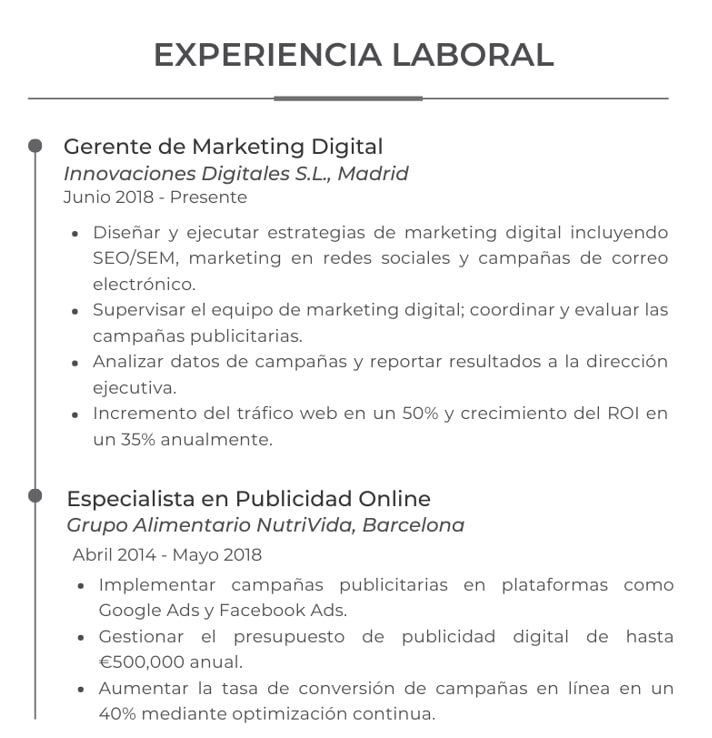
Step 5: Include Your Education (Formación Académica)
Showcase your education in the usual reverse chronological order and include the following points:
- Institution Name and Location: Write the name and location of the educational institution.
- Dates of Attendance: List the years you attended.
- Degree or Certification: Specify the degree or certificate obtained.
- Relevant Courses or Projects: Optionally, mention significant courses or projects that are particularly relevant to the job.
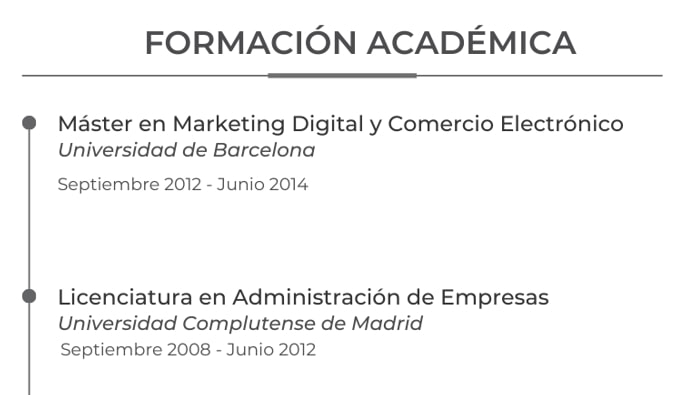
Step 6: List Relevant Skills (Habilidades)
- Languages: Specify your language skills and levels of fluency, especially your proficiency in Spanish.
- Technical Skills: Include software, tools, or technical skills pertinent to the job.
- Soft Skills: Mention applicable soft skills like leadership, teamwork, or problem-solving abilities.
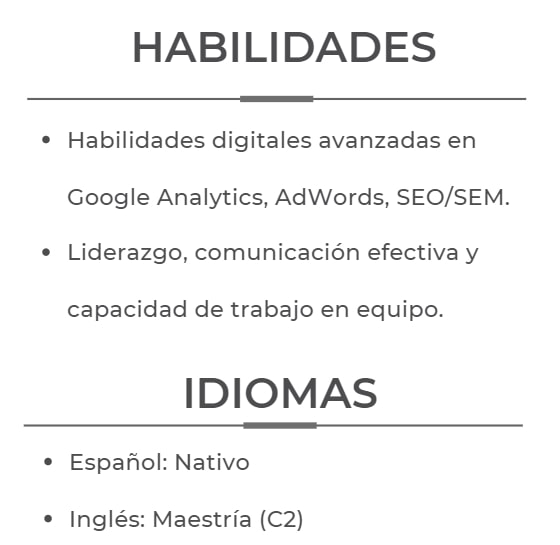
Step 7: Add Additional Sections as Needed
- Certifications (Certificaciones): List any professional certifications that are relevant to the job.
- Professional Development (Desarrollo Profesional): Include any courses, seminars, or workshops you've attended that contribute to your professional growth.
- Volunteer Experience (Experiencia Voluntaria): If relevant, include volunteer positions, particularly those that demonstrate skills applicable to the job.
- Hobbies/Interests (Aficiones/Intereses): Optionally, include hobbies or interests that might be relevant or show a well-rounded character.
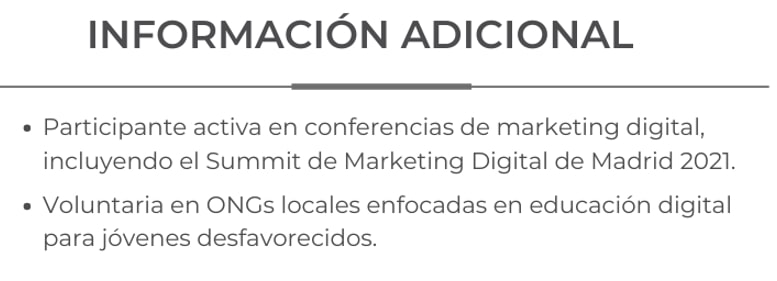
Step 8: Customise for the Job
Make your resume specific to the position you're going for, stressing the experience and abilities that are most relevant to the job description. Don’t forget to Include keywords from the job posting to ensure that your resume is relevant to what the company is looking for and efficiently passes through Applicant Tracking Systems (ATS).
Step 9: Proofread and Format Your Resume
Check for any grammatical or spelling mistakes and make sure the resume is clear and easy to read. Use a professional font and format on a regular basis. Keep it to one or two pages, depending on your experience.
Step 10: Final Review and Prepare for Submission
Double-check all information is presented consistently and appropriately represents your qualifications and professional position. You can use the check-list below or get comments from a mentor or peer who is experienced with the Spanish employment market.
Once everything is ready, remember to save your resume in a PDF format to preserve its layout.
Is the cover letter required? Read the job post again and, if not required, write a brief yet exhaustive email in Spanish to accompany your CV and present you to the possible employer.
Your Resume in Spanish: Final Check-List
- Customisation: For each application, tailor your CV in Spanish, highlighting how your experience matches the job description and corporate culture.
- Language Use: Use a professional and official tone while being accessible. Avoid slang and too complicated linguistic structures.
- Achievements over Responsibilities: Emphasise your accomplishments in your responsibilities, rather than your obligations.
- Strategic Keyword Use: To optimise for search engines and ATS (Applicant Tracking Systems), include crucial keywords related to the job post.
- Format & Length: A Spanish CV should be clear and simple, ideally fitting on one page, although it can be extended to two pages if more room is required to highlight significant professional experiences.
Spanish Resume Sample
That's all! Your Spanish CV is now ready for submission. Here is an example of a marketing-related CV. Does your CV like this one?
I am also including a text version of the CV, for easier copy and paste of some key parts.
Important: I picked the customised format since the Europass is only acceptable in Europe, and some firms consider it outdated. Anyway, if you're obliged to submit that one, you may do so by logging into the official European portal and creating it from scratch.
Laura Martínez Castillo
Dirección: Calle Flores 34, 28013 Madrid, España
Teléfono: +34 612 345 678
Correo electrónico: laura.martinez@example.com
Fecha de nacimiento: 14 de marzo de 1990
Foto profesional
Perfil Profesional
Profesional en marketing con más de 8 años de experiencia en la industria de bienes de consumo, especializada en estrategias de marketing digital y desarrollo de campañas publicitarias. Excelente manejo de herramientas analíticas y digitales, con un historial comprobado de aumento en la visibilidad de marca y crecimiento en ventas. Proactiva, creativa y con fuertes habilidades de liderazgo.
Experiencia Laboral
Gerente de Marketing Digital
Innovaciones Digitales S.L., Madrid
Junio 2018 - Presente
● Diseñar y ejecutar estrategias de marketing digital incluyendo SEO/SEM, marketing en redes sociales y campañas de correo electrónico.
● Supervisar el equipo de marketing digital; coordinar y evaluar las campañas publicitarias.
● Analizar datos de campañas y reportar resultados a la dirección ejecutiva.
● Incremento del tráfico web en un 50% y crecimiento del ROI en un 35% anualmente.
Especialista en Publicidad Online
Grupo Alimentario NutriVida, Barcelona
Abril 2014 - Mayo 2018
● Implementar campañas publicitarias en plataformas como Google Ads y Facebook Ads.
● Gestionar el presupuesto de publicidad digital de hasta €500,000 anual.
● Aumentar la tasa de conversión de campañas en línea en un 40% mediante optimización continua.
Formación Académica
Máster en Marketing Digital y Comercio Electrónico
Universidad de Barcelona
Septiembre 2012 - Junio 2014
Licenciatura en Administración de Empresas
Universidad Complutense de Madrid
Septiembre 2008 - Junio 2012
Habilidades
● Habilidades digitales avanzadas en Google Analytics, AdWords, SEO/SEM.
● Liderazgo, comunicación efectiva y capacidad de trabajo en equipo.
Idiomas
● Español: Nativo
● Inglés: Maestría (C2)
Información Adicional
● Participante activa en conferencias de marketing digital, incluyendo el Summit de Marketing Digital de Madrid 2021.
● Voluntaria en ONGs locales enfocadas en educación digital para jóvenes desfavorecidos.
Conclusion
A well-prepared Spanish resume opens doors and lays the groundwork for successful job interviews.
Take the time to create a polished, professional CV in Spanish that represents your credentials and cultural awareness.
For additional information on how to prepare for your job application process, see our previous post on Spanish job interviews.
With these tools and suggestions, you'll be better prepared to negotiate the Spanish-speaking employment market. Best of luck!
Author:

Fabia Parodi
Fascinated by foreign languages and cultures, Fabia Parodi was determined to be a polyglot since she was a child. Fluent in Italian, English, French and Spanish and competent in Mandarin Chinese, Fabia is an experienced language teacher, translator and multicultural marketing specialist.
When in class, she always make sure to include graded and authentic materials in her lessons to expose students to foreign cultures and to introduce a more natural use of the language they are learning. The two things she loves more than languages are travelling and exchanging stories with people from all over the world.
